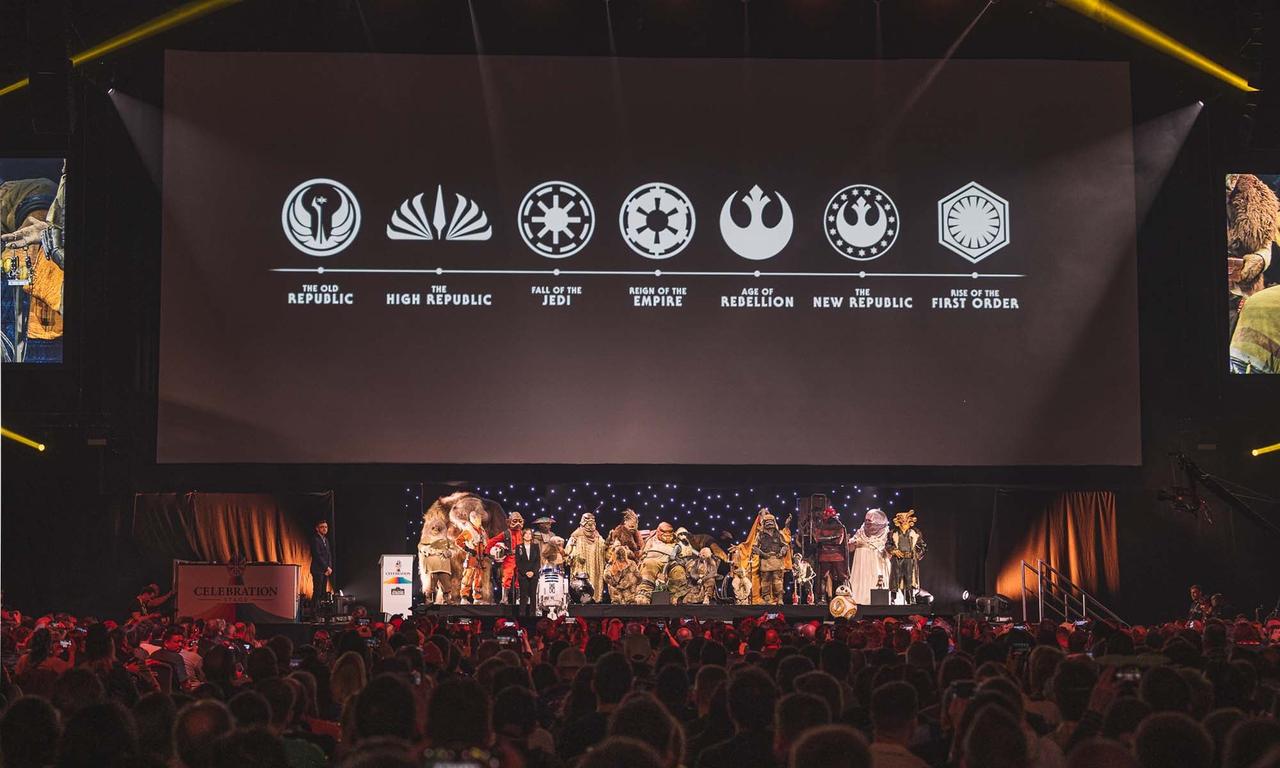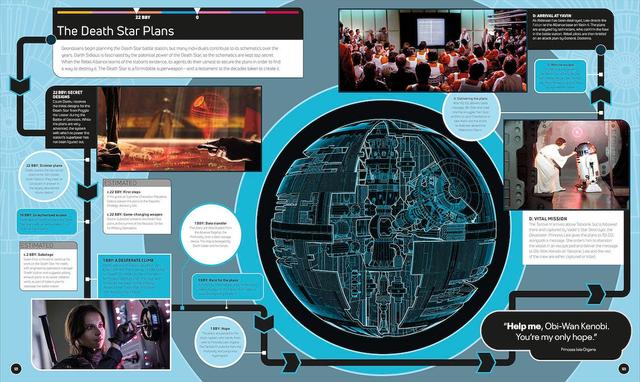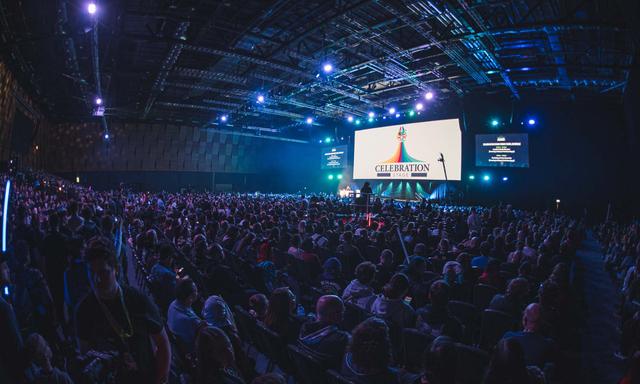If you click on a link and make a purchase we may receive a small commission. Read our editorial policy.
What the new Star Wars timeline means, and what it means in terms of chronology, as well
Breaking down the new timeline from long ago in a galaxy far, far away

Onstage during the Lucasfilm Studio Showcase at Star Wars Celebration Europe, the future of Star Wars was unveiled… and it looked a lot like the past of Star Wars… except further and deeper into the past than the series has ever gone, in addition to pushing the stories into what’s yet to come, as well.
The unveiling of a new timeline of the Star Wars saga — one that splits the chronology of the series into nine distinct eras, including the unveiling of three all-new eras never before visited onscreen. It’s a new approach to the Star Wars franchise that purposefully moves it away from the original 'Skywalker Saga' series of nine movies, and purposefully branches it into something significantly larger in time for the announcement of no less than three new movies in the works across the coming years.
The shift away from the previous understanding of the property isn’t merely moving away from the idea of “the Original Trilogy, the Prequel Trilogy, and the Sequel Trilogy” of movies, but one that intentionally places the Rebels/Empire storyline in a larger context that puts current Disney+ shows on an equal footing to the movies — while also introducing new stories and entirely new timelines that further de-emphasize the storyline that used to define 'Star Wars' in the minds of fandom.
It’s an exciting prospect for core Star Wars fandom — the promise of new mysteries and truths to uncover, and the idea that there’s so much more out there to enjoy — but perhaps a risky one for the casual fan, with Lucasfilm’s next three movies being set literally thousands of years apart from each other. Will the more casual fans be able to juggle the different timelines and eras of stories without some kind of guidance…? But then, perhaps that’s what a timeline like this one — which names each specific era and gives each a recognizable graphic to denote them — is intended to be: an easy-to-reference guide to when each movie, show, and storyline takes place for anyone, hardcore fan or newcomer.
The long term success of the revised timeline is something that will only truly become apparent over the next few years as Lucasfilm continues to roll it out, and audiences start to interact with it in movie theaters and on Disney+. But in the short term, you might be wondering just what the new timeline looks like, and which movies and shows fit in where. Thankfully, we’re here to help with that.
Star Wars: Dawn of The Jedi
While the title of James Mangold’s Star Wars project remains unknown, it’s very possible that it might be “Dawn of the Jedi,” based simply on the era title denoted by the new Lucasfilm graphic. We know that the movie will be, for all intents and purposes, an origin story for The Force, and focus on the first Jedi ever — but will it be a standalone story, or the start of a new franchise set millennia before the Star Wars stories fans are already familiar with? “A long time ago…” indeed.
Star Wars: The Old Republic
This is perhaps the most interesting element of the new timeline graphic, in that it’s not immediately clear what projects will be set during this time period. Leslye Headland specifically said that the upcoming Disney+ series The Acolyte will be set between The High Republic era and the Prequel trilogy of movies, which means it doesn’t fit into this era, based on the timeline. So… is The Old Republic placement incorrect, or is there a mystery Star Wars project in the works during this era?
Star Wars: The High Republic
The title given to the massive cross-publishing project being told in novels, YA books, and comic books since 2021, The High Republic is a storyline told in an era specifically defined as being between 350 and 50 years before events of the very first Star Wars movie, with the Jedi in their prime ahead of the Clone Wars and the foundation of the Galactic Empire — not to mention the end of the Jedi Order thanks to Order 66 and the systematic murder of every Jedi. (Or so the Emperor believed, at least.) As above, The Acolyte will also be set in a period that is, technically, The High Republic era.
Star Wars: Fall of the Jedi
Fall of the Jedi is a new overall branding for what used to be considered the Prequel Trilogy and related projects — which is to say, the period that saw the rise to power of Emperor Palpatine, and the execution of his plan to eradicate the Jedi Order. This includes not only Star Wars Episode I: The Phantom Menace, Star Wars Episode II: Attack of the Clones, and Star Wars Episode III: Revenge of the Sith, but also the Star Wars: The Clone Wars animated series.
Star Wars: Reign of the Empire
The Reign of the Empire period has been one visited often since Disney has taken over the Star Wars franchise; it’s the home not only to Rogue One: A Star Wars Story and Solo: A Star Wars Story, but also the Disney+ shows The Bad Batch, Obi-Wan Kenobi, and Andor., as well as the animated series Star Wars: Rebels. While no formal definition has been released by Lucasfilm as to what constitutes a cut-off line for the end of the Reign of the Empire, it’s safe to suggest that Rogue One would be where the tide truly begins to turn in the conflict for the heart of the galaxy, with the Rebellion finally becoming a true threat to the Empire.
Star Wars: Age of Rebellion
Unlike most of the other titles for the new Star Wars timeline, “Age of Rebellion” has been used before — it was the umbrella title for a series of comic books published by Marvel featuring characters from the original trilogy of movies. As such, it includes Star Wars: A New Hope, The Empire Strikes Back, and Return of the Jedi, and ends with the climax of that third movie, at which point the Rebellion ends, successfully, and instead transforms into… the New Republic.
Star Wars: The New Republic
The New Republic era is one that’s formed the spine of Dave Filoni and Jon Favreau’s growing Star Wars Disney+ empire — no pun intended — with The Mandalorian, The Book of Boba Fett, and the upcoming Ahsoka and Skeleton Crew, all taking place during this period. Importantly, this is also where Filoni’s upcoming feature debut will fall, with the movie acting as a big screen crossover continuation and culmination of many of the plot threads from those shows.
Star Wars: Rise of the First Order
Of course, if there’s one constant in a galaxy far, far away, it’s conflict — which explains why the remnants of the Empire re-emerged restyled as The First Order, leading to the events of the Sequel trilogy, which completed the Skywalker Saga as-was: Star Wars: The Force Awakens, Star Wars: The Last Jedi, and Star Wars: The Rise of Skywalker, as well as the many publishing projects related to those movies. There was a lot of them; you might want to check them out, because they might want to inform what’s coming up in what’s to come…
Star Wars: New Jedi Order
Going further into the timeline than the franchise ever has before — 15 years after the events of the Rise of Skywalker — the New Jedi Order takes its title from a series of novels published from 1999 through 2003 about Luke Skywalker’s rebuilding of the Jedi in the wake of the Original Trilogy of movies. Those books were rendered non-canonical in 2014, but the new New Jedi Order is centered around a similar idea, with another Jedi at the helm: Rey Skywalker (Daisy Ridley), in the new untitled movie from directed by Sharmeen Obaid-Shinoy. This is, quite literally, the future of Star Wars… in whatever shape it will take.
Check out everything that Popverse is covering this weekend in London at Star Wars Celebration..
About Star Wars Celebration 2023
Dates
-
Follow Popverse for upcoming event coverage and news
Find out how we conduct our review by reading our review policy
Let Popverse be your tour guide through the wilderness of pop culture
Sign in and let us help you find your new favorite thing.
















Comments
Want to join the discussion? Please activate your account first.
Visit Reedpop ID if you need to resend the confirmation email.